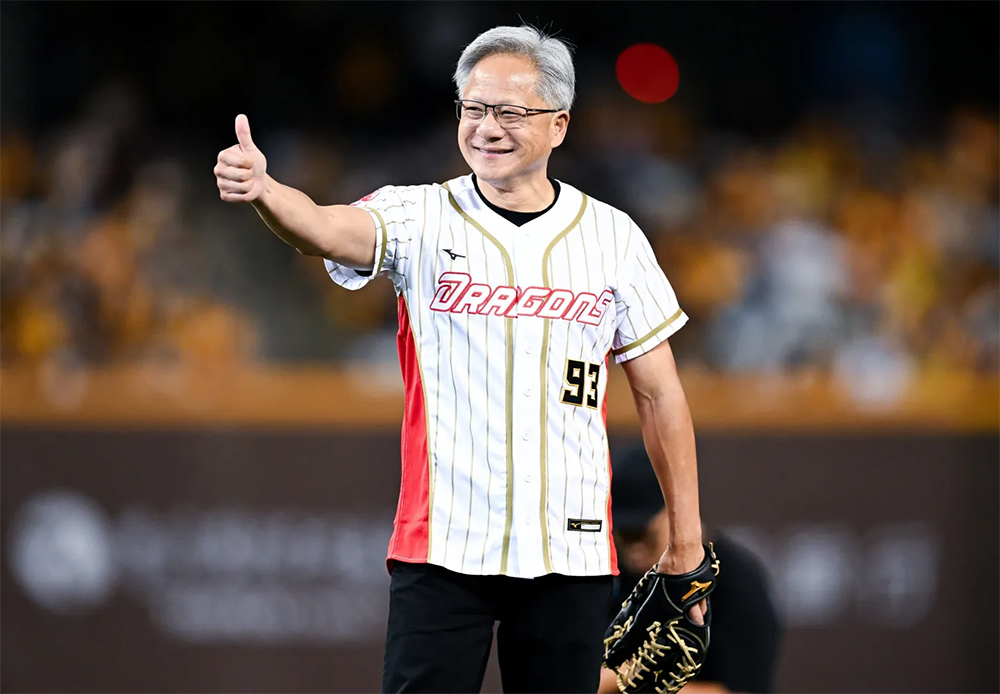
英偉達(Nvidia)副總裁西蒙娜·揚科夫斯基最近從市值高達3.1萬億美元的科技巨頭離職,,她對自己的上司和公司CEO黃仁勛表達了敬意。
在談到她在這位白手起家的億萬富翁手下工作的經歷時,,她總結說:“與黃仁勛共事是讓我終生難忘的一段經歷,。”
揚科夫斯基在該芯片制造商負責投資者關系和戰(zhàn)略融資已近七年,,她在LinkedIn上表示,,黃仁勛“獨樹一幟”,然后她分享了從黃仁勛身上學到的三條領導經驗:“第一性原理思維,、零億美元市場和光速執(zhí)行,。”
揚科夫斯基補充說:“他啟發(fā)我要挑戰(zhàn)極限,,他會讓我笑出眼淚,,還讓我學會了如何平衡工作與家庭?!?/p>
英偉達成為全球最有價值的公司,,得益于黃仁勛的第一性原理思維和零億美元市場理念
英偉達最初專注于為電腦游戲開發(fā)圖形處理器,,后來該公司發(fā)明了首批適用于人工智能的GPU,如今它已經成為市場主導者,,市場上出售的70%以上的人工智能芯片來自該公司,。
上周,英偉達曾短暫超過微軟(Microsoft),,以3.34萬億美元的市值成為全球最有價值的公司,。
揚科夫斯基自豪地表示,自從她于2017年加入英偉達以來,,她親眼見證公司營收增長了10倍,,利潤和市值增長了超過20倍。
她補充說:“或許更了不起的是,,英偉達旗艦GPU芯片的智算性能提高了1,000多倍,,而尖端人工智能模型的規(guī)模擴大了20,000多倍。經歷指數(shù)級增長是罕見且令人激動的過程,,而且讓我保持陡峭且令人興奮的學習曲線,。”
但英偉達在GPU領域的成功絕非偶然——它清晰地展示了黃仁勛的良好習慣,,即用第一性原則思維(即質疑每一種假設以找到問題的基本要素)找到創(chuàng)新解決方案而不是模仿現(xiàn)有的模式,,并在零億美元市場(即新興但潛力巨大的市場)發(fā)展業(yè)務。
之前,,誕生于上世紀50年代的CPU作為最常用的計算機芯片,,擅長逐個執(zhí)行復雜的計算,但到了2010年代,,隨著深度學習和人工智能研究的增多,,CPU已經無法滿足數(shù)據(jù)科學家們的需求。
而GPU可以一次處理多個簡單的計算,,且事實證明,,對于人工智能開發(fā)者創(chuàng)建和訓練大語言模型所需要的計算系統(tǒng),英偉達的GPU是最佳選擇,。
半導體資深研究分析師特里斯坦·杰拉對《財富》雜志表示:“黃仁勛富有遠見,,他很早就預見到GPU在數(shù)據(jù)中心的應用趨勢,并根據(jù)這個愿景調整了公司的策略,?!?/p>
英偉達富有遠見的舉措之一是,在2007年開發(fā)出一款高性能編程工具CUDA,,可以簡單的方式發(fā)揮其GPU的全部能力,。
CUDA目前應用廣泛,以至于開發(fā)大語言模型的公司,例如OpenAI的ChatGPT等,,很難考慮使用其他技術,。
正如黃仁勛之前所說的那樣,這就是在零億美元市場運營的意義所在,。
上個月,,他在接受Stripe的CEO帕特里克·克里森采訪時表示:“我們的使命是去做沒有人做過的事情,這些事情可能困難重重,,但只要你能做到,,就能做出真正的貢獻。
這個市場在規(guī)模上可能是一個零億美元市場,,因為以前這個市場并不存在,,我寧愿成為市場創(chuàng)造者,而不是市場接受者,。”
西蒙娜·揚科夫斯基是誰,?
揚科夫斯基畢業(yè)于斯坦福大學(Stanford University),,在加入英偉達之前,一直任職于高盛(Goldman Sachs),。
但她透露,,早在高盛工作期間,她與該芯片制造商之間就已經有非常密切的合作,。
她在LinkedIn上發(fā)帖解釋稱:“在2001年,,作為高盛一名新手股權研究分析師,我的第一個任務就是創(chuàng)建NVDA財務模型,。在我們的初期研究過程中,,我接觸到了黃仁勛?!?/p>
她說道,,她跟進了英偉達“炫酷的產品發(fā)布、飛快的技術進步,、前往中國臺灣的供應鏈考察”以及“對黃仁勛的問答”,,這讓她在分析師圈打響了自己的名號。
揚科夫斯基從基層做起,,在高盛全球投資研究部門從事了多年半導體行業(yè)研究,,后被提拔為總經理。
現(xiàn)在,,她將加入一家初創(chuàng)公司擔任首席財務官,,但她并未透露這家公司的具體信息。
《財富》雜志已向揚科夫斯基提出了置評請求。(財富中文網)
翻譯:劉進龍
審校:汪皓
英偉達(Nvidia)副總裁西蒙娜·揚科夫斯基最近從市值高達3.1萬億美元的科技巨頭離職,,她對自己的上司和公司CEO黃仁勛表達了敬意,。
在談到她在這位白手起家的億萬富翁手下工作的經歷時,她總結說:“與黃仁勛共事是讓我終生難忘的一段經歷,?!?
揚科夫斯基在該芯片制造商負責投資者關系和戰(zhàn)略融資已近七年,她在LinkedIn上表示,,黃仁勛“獨樹一幟”,,然后她分享了從黃仁勛身上學到的三條領導經驗:“第一性原理思維、零億美元市場和光速執(zhí)行,?!?
揚科夫斯基補充說:“他啟發(fā)我要挑戰(zhàn)極限,他會讓我笑出眼淚,,還讓我學會了如何平衡工作與家庭,。”
英偉達成為全球最有價值的公司,,得益于黃仁勛的第一性原理思維和零億美元市場理念
英偉達最初專注于為電腦游戲開發(fā)圖形處理器,,后來該公司發(fā)明了首批適用于人工智能的GPU,如今它已經成為市場主導者,,市場上出售的70%以上的人工智能芯片來自該公司,。
上周,英偉達曾短暫超過微軟(Microsoft),,以3.34萬億美元的市值成為全球最有價值的公司,。
揚科夫斯基自豪地表示,自從她于2017年加入英偉達以來,,她親眼見證公司營收增長了10倍,,利潤和市值增長了超過20倍。
她補充說:“或許更了不起的是,,英偉達旗艦GPU芯片的智算性能提高了1,000多倍,,而尖端人工智能模型的規(guī)模擴大了20,000多倍。經歷指數(shù)級增長是罕見且令人激動的過程,,而且讓我保持陡峭且令人興奮的學習曲線,。”
但英偉達在GPU領域的成功絕非偶然——它清晰地展示了黃仁勛的良好習慣,,即用第一性原則思維(即質疑每一種假設以找到問題的基本要素)找到創(chuàng)新解決方案而不是模仿現(xiàn)有的模式,,并在零億美元市場(即新興但潛力巨大的市場)發(fā)展業(yè)務。
之前,,誕生于上世紀50年代的CPU作為最常用的計算機芯片,,擅長逐個執(zhí)行復雜的計算,但到了2010年代,隨著深度學習和人工智能研究的增多,,CPU已經無法滿足數(shù)據(jù)科學家們的需求,。
而GPU可以一次處理多個簡單的計算,且事實證明,,對于人工智能開發(fā)者創(chuàng)建和訓練大語言模型所需要的計算系統(tǒng),,英偉達的GPU是最佳選擇。
半導體資深研究分析師特里斯坦·杰拉對《財富》雜志表示:“黃仁勛富有遠見,,他很早就預見到GPU在數(shù)據(jù)中心的應用趨勢,,并根據(jù)這個愿景調整了公司的策略?!?/p>
英偉達富有遠見的舉措之一是,,在2007年開發(fā)出一款高性能編程工具CUDA,可以簡單的方式發(fā)揮其GPU的全部能力,。
CUDA目前應用廣泛,,以至于開發(fā)大語言模型的公司,例如OpenAI的ChatGPT等,,很難考慮使用其他技術,。
正如黃仁勛之前所說的那樣,這就是在零億美元市場運營的意義所在,。
上個月,,他在接受Stripe的CEO帕特里克·克里森采訪時表示:“我們的使命是去做沒有人做過的事情,,這些事情可能困難重重,,但只要你能做到,就能做出真正的貢獻,。
這個市場在規(guī)模上可能是一個零億美元市場,,因為以前這個市場并不存在,我寧愿成為市場創(chuàng)造者,,而不是市場接受者,。”
西蒙娜·揚科夫斯基是誰,?
揚科夫斯基畢業(yè)于斯坦福大學(Stanford University),,在加入英偉達之前,一直任職于高盛(Goldman Sachs),。
但她透露,,早在高盛工作期間,她與該芯片制造商之間就已經有非常密切的合作,。
她在LinkedIn上發(fā)帖解釋稱:“在2001年,,作為高盛一名新手股權研究分析師,我的第一個任務就是創(chuàng)建NVDA財務模型。在我們的初期研究過程中,,我接觸到了黃仁勛,。”
她說道,,她跟進了英偉達“炫酷的產品發(fā)布,、飛快的技術進步、前往中國臺灣的供應鏈考察”以及“對黃仁勛的問答”,,這讓她在分析師圈打響了自己的名號,。
揚科夫斯基從基層做起,在高盛全球投資研究部門從事了多年半導體行業(yè)研究,,后被提拔為總經理,。
現(xiàn)在,她將加入一家初創(chuàng)公司擔任首席財務官,,但她并未透露這家公司的具體信息,。
《財富》雜志已向揚科夫斯基提出了置評請求。(財富中文網)
翻譯:劉進龍
審校:汪皓
Nvidia VP Simona Jankowski has just bid the $3.1 trillion tech giant farewell—and paid homage to her boss and CEO Jensen Huang on her way out.
“Working with Jensen has been the experience of a lifetime,” she concluded of her time reporting into the billionaire from humble beginnings.
After nearly seven years of running investor relations and strategic finance at the chipmaker, she gushed on LinkedIn that Huang is “in a class of his own” before sharing the three leadership lessons he taught her: “First principles thinking, zero-billion dollar markets, speed-of-light execution and so much more.”
“He inspired me to reach to the limits, made me laugh to tears, and taught me the harmony of work and family,” Jankowski added.
The world’s most valuable company—thanks to Huang’s first principles thinking and zero-billion dollar market concepts
After an initial foray into developing graphics processors for computer games, the company invented one of the first AI-friendly GPUs and now it’s dominating the market, selling over 70% of all AI chips.
Last week, Nvidia briefly topped Microsoft to become the world’s most valuable company with a market capitalization of $3.34 trillion.
Since Jankowski joined Nvidia in 2017, she boasted that she’s watched its revenue grow tenfold and its earnings and market cap have jumped by more than 20 times.
“Perhaps even more impressively, the AI compute performance delivered by NVIDIA’s flagship GPU is up over 1,000X, while the size of frontier AI models has grown by over 20,000X,” she added. “Living through exponentials like these is rare and thrilling, and keeps the learning curve steep and exciting.”
But Nvidia’s GPU success was no accident—it clearly demonstrates Huang’s habit of applying first principles thinking (that is, questioning every assumption to get to the basic element of a problem) to find innovative solutions instead of mimicking existing models, and forging a business in a zero-billion dollar market (that is, a nascent but potentially giant market).
Previously, CPUs—the most common computer chips, which date back to the 1950s—were great for executing complex calculations one at a time, but they didn’t quite fit the needs of data scientists when deep learning and AI research intensified in the 2010s.
But GPUs can perform many simple calculations at once—and as it turned out, Nvidia’s GPUs were a perfect fit for the type of computing systems AI developers needed to build and train large language models.
“Jensen is a visionary and saw the trends of GPU adoption in data centers early on and aligned the company’s strategy to that vision,” a semiconductors senior research analyst, Tristan Gerra, told Fortune.
One of its prescient moves included creating CUDA, a high-level programming tool the company built in 2007 to help unlock the full capability of its GPUs in a straightforward way.
CUDA is now so widely used that it’s difficult for companies building large language models like OpenAI’s ChatGPT to imagine themselves using other tech.
As Huang himself previously pointed out, that’s precisely what it means to operate in a zero-billion-dollar market:
“Almost all of our purposes should be to go and do something that hasn’t been done before, that is insanely hard to do, that if you achieve it could make a real contribution,” he told Stripe’s CEO Patrick Collison on stage last month.
“That market is probably zero billion dollars in size because it’s never been done before—I’d rather be a market maker than a market taker.”
Who is Simona Jankowski?
Jankowski, a Stanford University alum, worked at Goldman Sachs for her entire career before joining Nvidia.
But even then, Jankowski revealed that she had been working closely with the chipmaker for quite some time.
“As a newly minted equity research analyst at Goldman Sachs in 2001, my first assignment was building the NVDA financial model, and I met Jensen Huang as part of our initiation of coverage,” she explained in her LinkedIn post.
Following the company’s “cool product launches, rapid technology advances, supply chain trips to Taiwan” and “Q&As with Jensen”, she said, helped her make her name as an analyst.
Jankowski worked her way up the ranks, covering the semi-conductor industry within Goldman’s Global Investment Research division for years before being promoted to managing director.
Now, she’s off to join the world of startups as a chief financial officer—but she’s not yet revealed the venture in question.
Fortune has reached Jankowski for comment.






